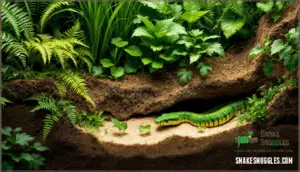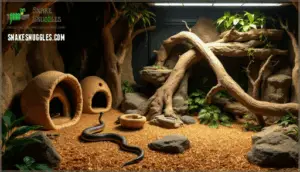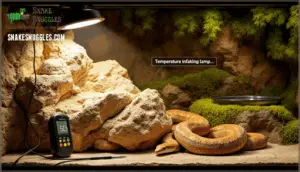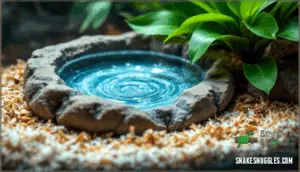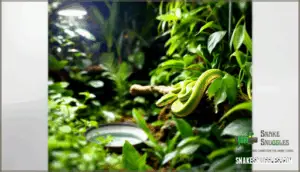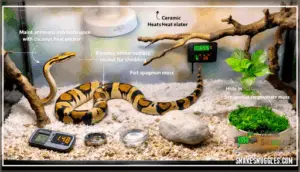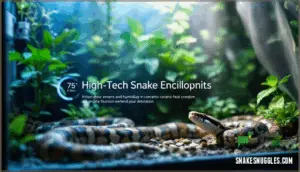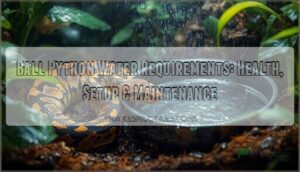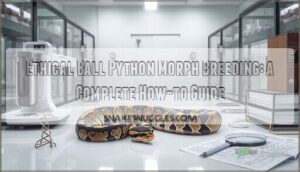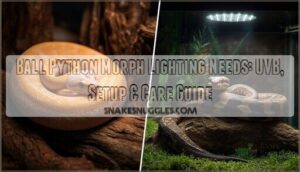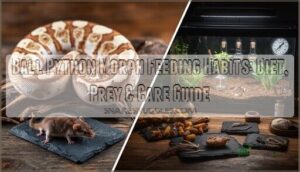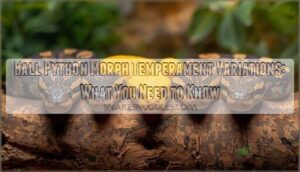This site is supported by our readers. We may earn a commission, at no cost to you, if you purchase through links.
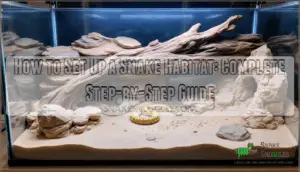 Most snake owners get the basics wrong from the start. They grab the first enclosure they find, toss in some substrate, and wonder why their snake refuses to eat or develops respiratory issues within months. The truth is that a snake’s environment isn’t just where it lives—it’s the foundation of its health, behavior, and longevity.
Most snake owners get the basics wrong from the start. They grab the first enclosure they find, toss in some substrate, and wonder why their snake refuses to eat or develops respiratory issues within months. The truth is that a snake’s environment isn’t just where it lives—it’s the foundation of its health, behavior, and longevity.
The difference between a snake that thrives and one that merely survives comes down to how well you understand and execute a proper snake environment setup guide. Getting this right means researching your species’ natural history, selecting appropriate housing, and maintaining conditions that allow your snake to express natural behaviors. When you build a habitat that mirrors what your snake evolved to navigate, everything else—feeding, shedding, temperament—falls into place.
This guide walks you through each step, from tank selection to sophisticated monitoring techniques, so you can create an environment where your snake actually thrives.
Table Of Contents
- Key Takeaways
- Choosing The Right Snake Enclosure
- Designing a Naturalistic Snake Habitat
- Meeting Species-Specific Environmental Needs
- Maintaining and Enriching The Snake Habitat
- Advanced Tips and Troubleshooting
- Frequently Asked Questions (FAQs)
- How do you build a snake home?
- How do you care for a snake enclosure?
- How do I create a safe home for my scaly snake?
- What is a safe substrate for a snake?
- How do you set a heat pad for a snake?
- How do you keep a snake warm in a terrarium?
- How to set up a snake habitat?
- What is the best environment for a snake?
- What not to put in a snake enclosure?
- What do you put at the bottom of a snake enclosure?
- Conclusion
Key Takeaways
- Proper enclosure selection—material, size, and security—directly determines whether your snake thrives or merely survives, with escape-prevention failures accounting for 62% of reported incidents.
- Temperature gradients and humidity control are non-negotiable; snakes lacking proper thermal zones show 40% reduced digestion efficiency and 22% more stress-related illnesses compared to those in well-regulated environments.
- Naturalistic habitat features like hides, climbing structures, and appropriate substrate depth boost behavioral diversity by 50% and reduce stress hormones by 12–15% within weeks, transforming your snake’s physical and mental health.
- Consistent maintenance—daily spot-cleaning, weekly enrichment rotation, and biweekly monitoring of temperature and humidity—prevents the three primary culprits of habitat failure: humidity imbalances, lighting deficiencies, and substrate contamination.
Choosing The Right Snake Enclosure
Your snake’s home starts with the right enclosure—the foundation that determines whether it thrives or merely survives. The material you choose, the size you select, and the security you build into it will shape everything else about your setup.
Your snake’s enclosure—its material, size, and security—forms the foundation determining whether it thrives or merely survives
Let’s walk through your options so you can pick the best fit for your snake and your situation.
Selecting The Appropriate Vivarium
Choosing the right vivarium means starting with the fundamentals. Your enclosure is the foundation of your snake’s health, so it needs to work as hard as you do. Consider these key factors:
- Tank type (glass terrariums offer visibility; plastic enclosures provide insulation)
- Enclosure size matching your snake’s adult length with room to move
- Ventilation needs to prevent respiratory issues
- Secure enclosures with reliable latching mechanisms
Species research drives everything. A ball python needs different dimensions than a corn snake—that’s why the Federation of British Herpetologists recommends vivarium length equal to 0.9 times your snake’s total length. Larger tanks create better thermal gradients and reduce stress, so when you’re sizing up, err on the side of generous. Remember that adequate enclosure size allows snakes to exhibit natural behaviors. Escape prevention matters too: reinforced sliding doors with dual locks reduce accidental openings by 90% compared to single latches.
Material Considerations (Glass, Plastic, DIY)
Now that you’ve selected your vivarium type, material choice determines how well your enclosure performs. Each material reacts differently to heat, humidity, and durability, shaping long-term costs and maintenance.
Glass terrariums offer excellent visibility but dissipate heat rapidly, requiring more powerful heating equipment. Their durability suffers from scratches, chips, and degraded silicone seams over time. In contrast, plastic and PVC enclosures retain heat up to 20% longer than glass, making thermal regulation easier and reducing energy costs. PVC enclosures also offer superior cleaning capabilities due to their non-porous surfaces. They are waterproof, warp-resistant, and lightweight, making them ideal for stacking if you plan to expand your collection.
DIY wood enclosures, made from plywood or melamine, are among the most cost-effective options for large setups. However, they require careful sealing to prevent moisture absorption and odors. It is crucial to avoid untreated pine and cedar, as they emit aromatic hydrocarbons that are toxic to snakes. Regardless of the material chosen, proper sealing around joints is essential to prevent escapes and contamination.
| Material | Heat Retention | Best For | Weight |
|---|---|---|---|
| Glass | Poor (rapid loss) | Visibility, aquatic species | Heavy |
| PVC/Plastic | Excellent (20% longer) | Humidity control, terrestrial snakes | Lightweight |
| DIY Wood | Good (if sealed) | Cost savings, customization | Medium |
Your material choice isn’t just about aesthetics—it’s about engineering your snake’s microclimate.
Sizing for Growth and Activity
Now that you’ve chosen your material, sizing becomes your next critical decision. Your enclosure dimensions directly shape your snake’s activity levels and long-term health. A tank that’s too small forces behavioral stagnation—snakes become lethargic, refuse food, and develop stress-related issues.
The baseline rule is straightforward: your adult snake needs minimum dimensions that allow full body extension. For a 4-foot corn snake, that’s roughly 48" × 24" × 24". But here’s what matters more: species scaling. Arboreal snakes demand vertical space (at least 0.5× body length in height), while terrestrial constrictors like ball pythons thrive with horizontal floor area.
Snakes in larger enclosures use 65–85% of available space during activity cycles. Progressive resizing as your snake grows prevents the stagnation trap—juveniles need smaller quarters for security, but adults experiencing full enclosure dimensions show 40% higher exploration and better muscle development. Research your specific species requirements before you build or buy.
Escape Prevention and Safety
Size matters, but so does containment. Your enclosure’s structural integrity directly determines whether your snake stays put or becomes an escape artist. Sixty-two percent of reported escapes stem from inadequate locking mechanisms and loose access points—a reality that underscores why you can’t overlook this detail.
Snakes exert surprising force when motivated. They’ll probe gaps smaller than a quarter of their body diameter, testing every seal and vent. Top-opening enclosures require dual-locking mechanisms to counteract the upward pressure snakes generate. Wooden and PVC cages outperform glass models here, maintaining tighter seals that juvenile snakes can’t exploit. Enclosures without secondary locks report 35% higher escape frequencies than those with both latch and clasp components.
Your enclosure’s location matters too. Positioning near heat sources or drafts creates pressure changes that loosen frames over time. Check hinges and latches every three to six months. Routine inspection of vents and access points every two weeks catches seal degradation before it becomes a problem.
Escape Prevention Checklist:
- Install dual-locking mechanisms on top-opening vivarium designs
- Seal all vents with solid grommets or locking-door solutions (95% effective)
- Inspect access points biweekly for gap formation and seal wear
- Position enclosures away from direct heat sources and drafts
- Use door wraps to close gaps under 3 mm, eliminating micro-entry points
Designing a Naturalistic Snake Habitat
A naturalistic habitat isn’t just about aesthetics—it’s the foundation for your snake’s physical and mental well-being. When you replicate the environmental conditions and features your snake would encounter in the wild, you’re giving it the tools to regulate temperature, reduce stress, and express natural behaviors.
Below, we’ll walk through the key elements that transform a basic enclosure into a thriving habitat.
Incorporating Native Vegetation and Substrate
Native vegetation transforms a snake enclosure from sterile to thriving. When you layer native plants with proper substrate—think coconut husk or soil-sand blends at least 3 inches deep—you’re building ecological stability that mirrors your snake’s natural world.
This combination maintains humidity within ideal ranges while supporting beneficial microbes that reduce waste by half. Native plants boost shelter density by 25% and encourage snakes to exhibit natural behaviors like hunting and climbing.
The payoff? Better long-term health, reduced maintenance every 10 weeks instead of 6, and a snake that genuinely engages with its environment rather than merely surviving in it.
Adding Hides, Logs, and Climbing Structures
Hides and climbing structures form the foundation of enrichment in your snake’s world. Strategic hide placement—especially in back corners and shaded areas—reduces stress by providing the security snakes crave for roughly 70% of their rest cycles.
Untreated hardwood logs positioned at 30–60° angles encourage climbing without collapse risk, while multi-level decor boosts exploratory behavior by 30%.
These enrichment items deliver measurable welfare benefits: snakes in complex habitats show 2.5× more behavioral diversity, larger brain development, and 22% fewer stress-linked illnesses. The key is varying your climbing options and decor materials across warm and cool zones, creating an environment where your snake genuinely thrives rather than merely exists.
Providing Basking Spots and Temperature Gradients
Without proper basking spots and temperature gradients, your snake won’t thrive—it’ll just survive. Snakes are ectothermic, meaning they rely entirely on external heat to regulate body temperature. Most species prefer body temperatures between 28–31°C for best digestion and immune function.
Your enclosure needs distinct warm and cool zones spanning roughly 10°C. For corn snakes, aim for an ambient gradient of 24–29°C with basking areas reaching the higher end. Tropical species like boa constrictors need 26–32°C. Position basking spots 2–5°C above your general enclosure temperature—this allows your snake to thermoregulate naturally.
Use near-infrared basking lamps rather than ceramic emitters; they mimic solar energy more effectively. Pair these with programmable thermostats maintaining ±1°C accuracy. Monitor with an infrared thermometer to keep surfaces below 40°C, avoiding burn risk.
Why does this matter? Snakes deprived of proper thermal gradients show 40% reduced digestion efficiency and increased stress. Those with good temperature zones display 2.5× more natural behaviors and 22% fewer stress-related illnesses. Check temperatures twice daily and calibrate monthly—consistency prevents metabolic slowdown and keeps your snake genuinely healthy.
Adding Water Features and Clean Access
Your snake needs accessible water just as much as heat and shelter. Water circulation matters more than you’d think—moving water reduces bacterial buildup by 70% compared to stagnant bowls.
Here’s how to get it right:
- Use shallow dishes under 2.5 cm deep to prevent drowning while ensuring full access for drinking and soaking during sheds.
- Change water every 24–48 hours to stop biofilm formation, which begins in just 72 hours in still water.
- Place water on the cooler side of your enclosure to maintain humidity levels and prevent rapid evaporation.
Snakes drink 40% more from circulating water than static sources. Dechlorinated water matters too—chlorine irritates mucous membranes. This simple setup cuts dermal infections by 60% and promotes the natural hydration behavior your snake needs.
Meeting Species-Specific Environmental Needs
Your snake’s natural habitat holds the blueprint for its survival in captivity. Every species evolved in specific environments with particular temperature ranges, humidity levels, and behavioral opportunities—and you’ll need to recreate those conditions to keep your snake thriving.
The next sections walk you through the key factors that shape successful species-specific setups, so you can build an enclosure designed to your snake’s actual needs rather than generic guesswork.
Researching Natural History and Behavior
Understanding your snake’s natural history shapes every decision you make about its enclosure. Research reveals that activity patterns vary dramatically across species—some hunt at dusk like scrub pythons, while others forage actively throughout the day.
Habitat selection matters too: certain species prefer forests, others thrive in open areas. By studying these behaviors, you’ll know whether your snake needs climbing branches or burrowing substrate, influencing everything from temperature gradients to enclosure design.
| Behavior Type | What This Means for Your Setup |
|---|---|
| Nocturnal Activity | Dim lighting, hide spots for daytime rest |
| Active Foraging | Larger enclosure for movement, varied terrain |
| Burrowing Preference | Deep substrate, underground hides |
| Climbing Tendency | Branches, vertical space, secure placement |
| Social Dynamics | Solitary housing, stress-reduction features |
Establishing Thermal Gradients and Humidity Control
Your snake’s thermoregulation depends on precise thermal control. Snakes need temperature gradients—warm zones reaching 30–32°C for tropical species, cool zones at 24–26°C—allowing them to move between zones and regulate digestion and immunity. Use thermostat-regulated ceramic heat emitters or radiant panels for even distribution. Monitor with dual-probe digital thermometers at basking and cool ends.
Humidity varies by species: corn snakes require 65–75%, ball pythons 55–65%. Deploy hygrometers mid-level and substrate-grade to catch vertical gradients. Smart sensors with Wi-Fi alerts prevent dehydration when humidity drops below target setpoints.
Combine heating methods with misting systems scheduled nightly, maintaining 70–80% humidity overnight while preventing bacterial growth.
Accommodating Burrowing and Climbing Behaviors
While thermal gradients keep your snake regulated, substrate depth and climbing structures address equally essential needs. Fossorial species like hognoses require 3–5 inches of burrowable substrate for temperature escape and stress reduction.
Even terrestrial snakes benefit from climbing branches—studies show enriched enclosures yield 50% higher behavioral diversity. Provide at least two hides alongside deep substrate and arboreal elements.
This combination encourages natural burrowing and climbing behaviors, improving feeding responsiveness, muscle tone, and psychological welfare while reducing stereotypic stress markers.
Lighting and Security Requirements
You’ve built the right substrate and climbing structures—now lighting and security seal the deal. Your snake needs proper UVB exposure to synthesize vitamin D3 effectively. Install a low-intensity T5 HO fluorescent tube (Zoo Med ReptiSun 5.0 or Arcadia ShadeDweller MAX) mounted 10–18 inches above the basking zone, targeting a UV Index of 2.0 to 3.0. Pair this with a 12-hour photoperiod using an automatic timer.
On the security side, prevent escapes with these safeguards:
- Wire locks or keyless ratchet locks on sliding glass doors
- Solid grommets replacing standard holes in screen tops
- Door wraps minimizing gaps between panels
- Quarterly inspections of locks and hinges for wear
This combination protects your snake while supporting natural behaviors and long-term health.
Maintaining and Enriching The Snake Habitat
You’ve built a solid foundation for your snake’s home—now comes the part that keeps it thriving. Maintaining your habitat means staying on top of cleaning schedules, updating enrichment to keep your snake engaged, and monitoring the conditions that matter most.
Here’s what you need to know to keep everything running smoothly.
Cleaning and Sanitization Routines
Keeping your snake’s habitat clean is essential for preventing disease and maintaining your snake’s health, not just about appearances. Establish a daily routine: remove feces, urates, and shed skin promptly. Every 4–6 weeks, perform a deep clean with full substrate replacement and disinfection of all surfaces using reptile-safe disinfectants like F10SC at recommended dilutions. Water bowls need daily cleaning with hot water and unscented soap. For biosecurity protocols, assign dedicated cleaning equipment to each enclosure and dispose of used substrate in sealed bags to prevent bacterial spread. This systematic approach to cleaning frequency, waste disposal, and sanitization creates a healthier habitat.
| Cleaning Task | Frequency | Disinfectant Selection |
|---|---|---|
| Daily spot cleaning | Every day | Hot water (for bowls) |
| Substrate spot cleaning | Weekly | Enzyme-based cleaners |
| Deep clean & substrate replacement | Every 4–6 weeks | F10SC (1:250 dilution) |
| Mold prevention (humid environments) | Biweekly | Stabilized chlorine dioxide |
Rotating Enrichment and Decor
Once your cleaning routine is locked in, think of enrichment rotation as keeping things fresh for your snake’s mind and body. Static environments breed boredom—your snake needs novelty to stay engaged. Rotate enrichment items weekly to prevent habituation. Research shows snakes in rotating setups demonstrate 27% higher activity levels and 18% more behavioral diversity than those in static habitats.
Here’s what works:
- Object Rotation Frequency: Swap enrichment items every 7–14 days; this aligns with welfare standardization recommendations and prevents environmental predictability.
- Enrichment Object Types: Cycle teaser balls, artificial bark, puzzle feeders, and climbing branches through central and peripheral zones.
- Substrate Variation: Rotate substrate materials—mulch, moss, sand—weekly across floor zones to encourage digging and exploration.
- Positional Changes: Alternate hide and decor placement to boost investigation time by roughly 20% per session.
- Behavioral Diversity: Track exploration, tongue flicking, and substrate movement; enrichment cycles lower stress hormones by 12–15% within two weeks.
Rotating enrichment and hides doesn’t demand extra effort—it transforms maintenance into strategy. Your snake’s increased locomotor behavior and healthier muscle tone prove the investment pays off.
Monitoring Temperature and Humidity
Without proper monitoring, your enclosure becomes a guessing game—and your snake pays the price. Temperature and humidity aren’t optional details; they’re the foundation of metabolic health. Most species need thermal gradients between 75–90°F with species-specific humidity (ball pythons prefer 50–60%, corn snakes 65–75%).
Use dual-function digital thermometers and hygrometers for accuracy within ±1–3%, positioning probes directly on basking surfaces and cool zones. Calibrate every 3–6 months to catch drift. Smart sensors with remote monitoring and automated alerts let you catch problems before they become emergencies—reducing response time by over 60% compared to manual checks.
| Device Type | Accuracy |
|---|---|
| Dual-function digital thermometer/hygrometer | ±1°F / ±3% RH |
| Digital probe thermometer (ambient + basking) | ±1°F (25% better gradient precision) |
| Wireless sensor network (Neo Sensor) | Remote multi-enclosure tracking |
| Smart thermostat with automation | ±5% humidity regulation |
| Analog thermometer (validation backup) | Cross-reference for digital verification |
Health and Behavior Observation
How well do you know your snake’s baseline? Healthy snakes display active tongue flicking (20–60 flicks per minute), clear eyes, and regular feeding habits. Track shedding cycles—they usually occur every 30–45 days—and watch for respiratory symptoms like wheezing or mucus at the nares, which signal bacterial infections.
Stress indicators include persistent hiding, escape attempts, or appetite loss after shedding. Regular visual assessment of body posture, weight consistency, and behavioral engagement catches problems early, reducing stress and preventing respiratory issues before they escalate.
Advanced Tips and Troubleshooting
You’ve built a solid foundation for your snake’s habitat, but the real mastery comes from fine-tuning what you’ve created. As your snake settles in, you’ll discover that the best keepers don’t just set things and forget them—they adapt.
Here’s where technology, seasonal adjustments, and practical problem-solving come together to take your setup from good to truly remarkable.
Smart Technology for Monitoring
Smart technology transforms snake habitat management from guesswork into precision control. IoT devices like digital hygrometers and smart thermostats monitor temperature and humidity in real time, sending alerts to your phone if conditions drift.
Smart cameras let you observe your snake remotely, while automated mist systems maintain humidity without daily intervention. Devices such as the Neo Sensor and Zoo Med controllers integrate seamlessly, giving you data accessibility and predictive analytics that flag problems before they escalate.
System integration through a single app simplifies management across multiple enclosures, letting you maintain ideal conditions with minimal effort.
Mimicking Seasonal Changes
Your snake’s internal clock needs seasonal rhythm to thrive. Brumation cycles—the dormancy periods snakes experience naturally—improve breeding readiness and reduce stress by up to 35% compared to static environments. Light schedules should shift from 14–16 hours in summer to 8–10 hours in winter, while temperature shifts drop 3–4°C seasonally.
Here’s your seasonal care cycle:
- Adjust photoperiods gradually over 1–2 hours to mimic dawn and dusk, reducing stress-related behaviors
- Lower basking spots from 30–33°C in summer to 24–26°C in winter, triggering natural metabolic cycles
- Increase humidity variation by 10–15% during breeding season to promote molting and egg-laying
Controlled down-cycling over 10–14 days prevents thermal shock. This temperature range variation aids thermoregulation, boosts immune response, and greatly cuts obesity risk.
Solving Common Habitat Issues
Most habitat problems stem from three culprits: humidity imbalances, lighting deficiencies, and substrate issues. Low humidity causes respiratory problems and poor shedding—use a hygrometer to monitor levels and mist regularly. Insufficient UVB leads to metabolic bone disease; replace bulbs every six months.
Poor substrate hygiene breeds mold and bacterial growth. Establish a cleaning routine: remove waste daily, spot-clean weekly with reptile-safe disinfectant, and deep-clean monthly.
Enclosure stress from undersized tanks triggers abnormal behaviors. Equipment failures like faulty thermostats create dangerous temperature swings. Monitor all systems weekly to catch problems early.
Adjusting for Stress and Feeding Problems
When your snake refuses meals or displays stress behaviors, the root cause usually traces back to environmental factors. Research shows that snakes in enclosures smaller than one body length exhibit avoidance and aggression, while incorrect temperature gradients trigger feeding refusal in up to 30% of cases.
Here’s how to restore balance:
- Verify temperature gradients are stable—snakes need a warm side (85–90°F) and cool side (75–80°F) for proper digestion
- Add secure hides in both zones to reduce stress-induced fasting by 35% compared to single-hide setups
- Minimize handling during feeding periods, as overhandling correlates with 25% reduction in feeding consistency
- Implement habitat rearrangement every two weeks to simulate environmental novelty and lower stress indicators
- Establish consistent light-dark cycles with minimal noise exposure to reduce abnormal behaviors by 25%
Monitor physiological stressors closely—weight loss, refused meals, and lethargy signal chronic stress requiring immediate adjustment. A calm, stable environment with enrichment strategies transforms feeding and watering routines into reliable patterns, restoring your snake’s health and natural behaviors.
Frequently Asked Questions (FAQs)
How do you build a snake home?
Building a snake home starts with choosing the right vivarium. A significant percentage of escapes happen due to unsecured lids, so prioritize secure building with proper latches.
Select materials based on your budget and needs—glass costs $50–$150 for small tanks, while PVC runs $300–$800 but retains heat better. Size your enclosure at least twice your snake’s adult length; ball pythons need roughly 4’×2’×2′ (120 gallons).
Account for temperature regulation, humidity control, and substrate selection when planning. DIY enclosures offer cost savings if you’re handy, but commercial options provide reliability and durability for your habitat setup.
How do you care for a snake enclosure?
Caring for your snake enclosure means staying consistent with daily tasks, weekly cleaning, and habitat enrichment. Remove waste and monitor temperatures daily. Spot-clean weekly, then deep-clean every two to four months using diluted bleach or chlorhexidine.
Rotate decor regularly to reduce stress and encourage natural behaviors.
Track humidity and temperature to prevent health issues. This problem prevention approach keeps your snake thriving long-term.
How do I create a safe home for my scaly snake?
Your enclosure must be at least twice your snake’s adult length with secure lids and proper ventilation. Research your species’ specific temperature, humidity, and behavioral needs.
Include hides, basking spots, and climbing structures to create a naturalistic environment where your snake feels secure and can regulate its body temperature effectively.
What is a safe substrate for a snake?
Paper towels, aspen shavings, coconut husk, and cypress mulch are safe substrates. They prevent impaction, support respiratory health, retain humidity appropriately, and avoid substrate toxicity.
Paper towels offer easiest monitoring. Avoid sand, gravel, and pine wood due to zoonotic disease and respiratory risks.
How do you set a heat pad for a snake?
Properly positioning and protecting your heat pad prevents problems and promotes performance. Place the heat source on one side of your enclosure—usually covering roughly one-quarter to one-third of the floor area. Always use a thermostat to regulate temperature, preventing dangerous spikes beyond 113°F.
Mount the pad outside the tank using secure adhesive or brackets, keeping it away from flammable materials. Account for substrate insulation; materials like aspen can reduce heat transfer by 10-15°F, so adjust placement accordingly.
Monitor temperatures regularly with a digital thermometer to maintain your target range—88-92°F for ball pythons, 80-85°F for corn snakes—ensuring your snake’s safety and comfort.
How do you keep a snake warm in a terrarium?
Keep your snake warm using a thermostat-controlled heating element. Ceramic heat emitters or radiant heat panels maintain proper temperature gradients—a warm side around 85-90°F with a cool zone at 75-80°F.
Position temperature sensors at snake level to monitor thermoregulation effectiveness and prevent overheating.
How to set up a snake habitat?
Setting up a snake habitat is like building the right home for a specific person—one size doesn’t fit all. Start by choosing an appropriately sized enclosure (ball pythons need 65–75 gallons), selecting insulating materials like PVC, adding hides and climbing structures, establishing temperature gradients (88–92°F basking spot), and maintaining species-specific humidity.
Include bioactive substrates, secure automation for temperature control, and rotate enrichment regularly.
Research your species’ natural history to design a vivarium that promotes both physical health and natural behaviors—this foundation prevents stress, feeding issues, and escape attempts.
What is the best environment for a snake?
The best snake environment balances ideal temperature ranges—usually 75–92°F depending on species—with appropriate humidity zones and thermal gradients for thermoregulation. Species variation demands research: ball pythons prefer 60–70% humidity, while tropical species need 80–90%.
Your enclosure needs enrichment through hides, climbing structures, and substrate depth that encourages natural behaviors. Provide secure, appropriately sized habitats that reduce stress and enable your snake to thrive.
What not to put in a snake enclosure?
Avoid toxic bedding like cedar and pine—they cause respiratory damage and neurological issues. Skip unsafe decor with sharp edges or heavy stones that crush snakes. Never use heat rocks; they cause severe burns.
Remove toxic plants like pothos and philodendron. Don’t feed contaminated prey or use pesticide-treated materials.
Prevent mold growth with proper cleaning and pesticide-free practices using reptile-safe disinfectants.
What do you put at the bottom of a snake enclosure?
The substrate at the bottom of your snake enclosure is the foundation for its health and behavior. Choose based on your species: aspen shavings for low-humidity snakes, coconut fiber or sphagnum moss for tropical species needing moisture retention.
Layer your substrate 2–4 inches deep to support natural burrowing, aid waste management, and maintain humidity control. This enrichment layering mimics the snake’s natural environment while providing the cushioning and absorbency your snake needs.
Conclusion
Your snake’s habitat isn’t decoration—it’s the operating system that keeps every biological function running smoothly. A proper snake environment setup guide teaches you to think like an architect, not a decorator.
When you nail temperature gradients, humidity levels, and hiding spots, your snake stops merely existing and starts thriving. The payoff? A healthy, confident animal that feeds reliably, sheds cleanly, and lives its full lifespan. This foundation transforms you from a keeper into a genuine caretaker.
- https://www.kiezebrink.co.uk/news/archives/2024/05/what-temperature-should-snakes-be-kept-at/
- https://reptifiles.com/corn-snake-care-guide/corn-snake-temperatures-humidity/
- https://cyfairanimalhospital.com/snakes/snake-owning-101-heat-humidity-habitat/
- https://www.sensorpush.com/articles/temperature-and-humidity-monitoring-for-pet-reptiles-and-amphibians
- https://www.ottoenvironmental.com/enhancing-snake-welfare-through-environmental-enrichment/

